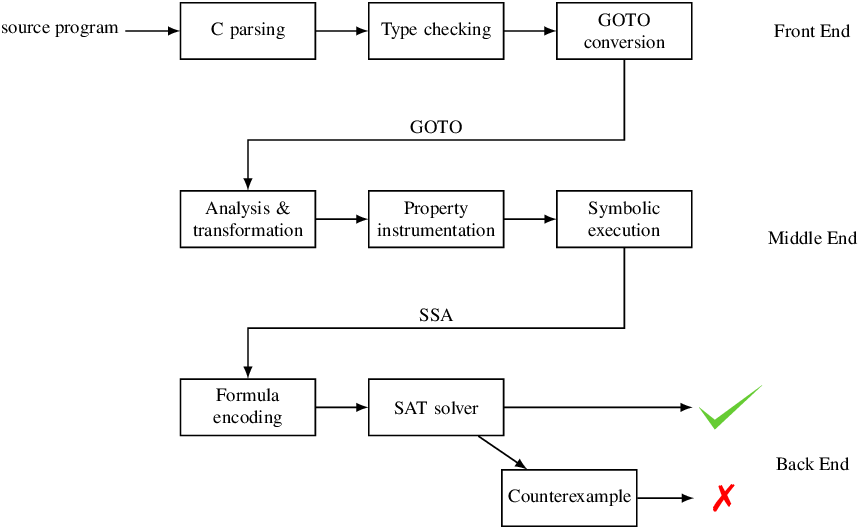sean anderson's "bit-twiddling hacks" contains a collection of clever bit manipulation tricks used to implement standard operations. the website claims that in 2005 that randy bryant had verified them using his own bit-blasting verifier based on BDDs (an ancestor of the current uclid5 verification tool).
cbmc is a verifier for c programs based on bounded model checking (hence the name). it symbolically simulates programs, using bounded unrollings of loops and bounded recursion, converting c code into a low-level bit representation using bit-blasting, and ends with calls to a sat solver to check properties (typically specified as assertions) hold by showing that boolean formula encodings it's negation is unsatisfiable.
most of these bit hacks have been verified by using a "reference implementation" and asserting that the two implementations are the same.
- Compute the sign of an integer
- Detect if two integers have opposite signs
- Compute the integer absolute value (abs) without branching
- Compute the minimum (min) or maximum (max) of two integers without branching
- Determining if an integer is a power of 2
- Sign extending
- Sign extending from a constant bit-width
- Sign extending from a variable bit-width
- Sign extending from a variable bit-width in 3 operations
- Conditionally set or clear bits without branching
- Conditionally negate a value without branching
- Merge bits from two values according to a mask
- Counting bits set
- Counting bits set, naive way
- Counting bits set by lookup table
- Counting bits set, Brian Kernighan's way
- Counting bits set in 14, 24, or 32-bit words using 64-bit instructions
- Counting bits set, in parallel
- Count bits set (rank) from the most-significant bit upto a given position
- Select the bit position (from the most-significant bit) with the given count (rank)
- Computing parity (1 if an odd number of bits set, 0 otherwise)
- Compute parity of a word the naive way
- Compute parity by lookup table
- Compute parity of a byte using 64-bit multiply and modulus division
- Compute parity of word with a multiply
- Compute parity in parallel
- Swapping Values
- Swapping values with subtraction and addition
- Swapping values with XOR
- Swapping individual bits with XOR
- Reversing bit sequences
- Reverse bits the obvious way
- Reverse bits in word by lookup table
- Reverse the bits in a byte with 3 operations (64-bit multiply and modulus division)
- Reverse the bits in a byte with 4 operations (64-bit multiply, no division)
- Reverse the bits in a byte with 7 operations (no 64-bit, only 32)
- Reverse an N-bit quantity in parallel with 5 * lg(N) operations
- Modulus division (aka computing remainders)
- Computing modulus division by 1 << s without a division operation (obvious)
- Computing modulus division by (1 << s) - 1 without a division operation
- Computing modulus division by (1 << s) - 1 in parallel without a division operation
- Finding integer log base 2 of an integer (aka the position of the highest bit set)
- Find the log base 2 of an integer with the MSB N set in O(N) operations (the obvious way)
- Find the integer log base 2 of an integer with an 64-bit IEEE float
- Find the log base 2 of an integer with a lookup table
- Find the log base 2 of an N-bit integer in O(lg(N)) operations
- Find the log base 2 of an N-bit integer in O(lg(N)) operations with multiply and lookup
- Find integer log base 10 of an integer
- Find integer log base 10 of an integer the obvious way
- Find integer log base 2 of a 32-bit IEEE float
- Find integer log base 2 of the pow(2, r)-root of a 32-bit IEEE float (for unsigned integer r)
- Counting consecutive trailing zero bits (or finding bit indices)
- Count the consecutive zero bits (trailing) on the right linearly
- Count the consecutive zero bits (trailing) on the right in parallel
- Count the consecutive zero bits (trailing) on the right by binary search
- Count the consecutive zero bits (trailing) on the right by casting to a float
- Count the consecutive zero bits (trailing) on the right with modulus division and lookup
- Count the consecutive zero bits (trailing) on the right with multiply and lookup
- Round up to the next highest power of 2 by float casting
- Round up to the next highest power of 2
- Interleaving bits (aka computing Morton Numbers)
- Interleave bits the obvious way
- Interleave bits by table lookup
- Interleave bits with 64-bit multiply
- Interleave bits by Binary Magic Numbers
- Testing for ranges of bytes in a word (and counting occurances found)
- Determine if a word has a zero byte
- Determine if a word has a byte equal to n
- Determine if a word has byte less than n
- Determine if a word has a byte greater than n
- Determine if a word has a byte between m and n
- Compute the lexicographically next bit permutation
